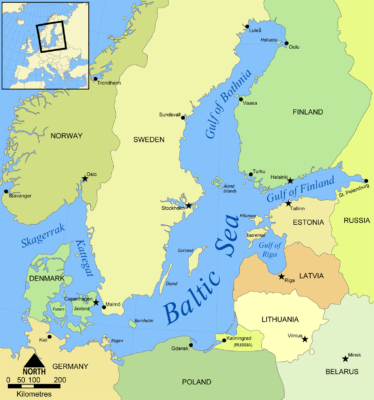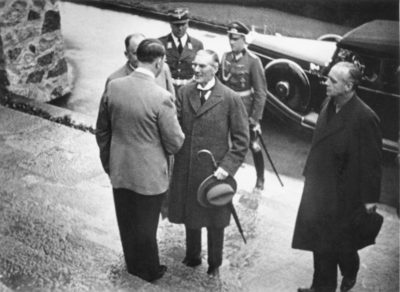Una Bergmane, fpri.org

In 2014, Russian Chanel One reported that Ukrainian officials had crucified a three year old boy. The heartbreaking story was told by a sole witness named Galina Pyshnika who presented herself as a pro-Russian refuge from Ukraine. This story was fake and subsequently debunked by Russian opposition, Ukrainian activists, and Western media. The so-called witness turned out to be a paid actress who later appeared in other Russian media horror stories about Ukrainian atrocities in completely different roles. This story is not unique—it is typical of Russian information operations. Countries such as the Baltic states, which are victims of Russian information efforts, need to develop a clearer strategy to deal with the threat.
Conflicts of the Future are Occurring before Our Eyes
In 1999, political scientists John Arquilla and David Ronfeldt argued that the conflicts of the future increasingly would be about which story wins. The recent Russian aggression in Ukraine, as well as fake news and cyber hacks in the U.S. and Europe, shows the accuracy of their decades-old prediction. While Western governments debated if and how they should support Ukraine, Russian officials sought to delegitimize the Ukrainian state and deny Russian aggression.
Political and military conflicts have always been accompanied by propaganda, but the internet and the increase of global interconnectivity make the spread of anonymous rumors and fake news easier than ever. These developments are particularly worrisome for former Soviet states. Many of these states (Estonia, Latvia, Lithuania, Moldova, Georgia, etc.) are geographically small and militarily weak. Their capabilities to endure political, economic, or even military standoffs with Russia directly depend on their ability to mobilize Western support. Russia’s recent online propaganda buildup aimed at Western media, elites, and public complicates this task. As the Ukraine example shows, former Soviet republics are still too often perceived as a “legitimate Russian zone of influence” and thus supposed to accept limitations of their sovereignty.
The Baltic states might seem exceptional because of their NATO membership, but in the case of a major crisis in Baltic-Russian relations, the activation of NATO’s Article V would depend on decisions made by each national government. It can be hoped—but not taken for granted—that these decisions would be fast and positive. Conflicts in 21st century Europe are not going to be conventional; they will be hybrid wars that blend conventional and unconventional warfare, regular and irregular warfare, as well as information and cyber warfare. As the Ukrainian war shows, this type of warfare aims to create confusion in the West about the causes of the conflict and the extent of Russian involvement. Russia relies on creating competing narratives to create confusion. In the case of escalating tensions between Moscow and the Baltic capitals, Moscow would deny its involvement or even the existence of an inter-state conflict. It would be up to the governments in Riga, Vilnius, and Tallinn to rebuke Russian disinformation.
What Can the Baltic States Do?
How could Russia’s small neighbor states prepare themselves for a possible crisis? What tools can they use, and what strategies should they have in place in order to be able to rapidly mobilize international support in case of such a crisis?
 A wide range of measures should be taken, varying from domestic nation building to traditional diplomacy. Over the last several years, the governments of the Baltic states have done a lot in terms of domestic policies, modernization of armed forces, and foreign policy. While these achievements have been discussed elsewhere, this article proposes a discussion on how a less traditional tool—public diplomacy—can be used to shape the security environment. Over the last 25 years, institutions in the Baltic states (foreign ministries, Latvian Institute, Estonian Institute, and others) have deployed serious efforts in this field, but these activities rarely have been seen as a question of national security. Public diplomacy has traditionally been defined as state-sponsored communication with foreign populations. It often has been misperceived as either a polite term for propaganda or merely a tool for boosting the tourism industry and sharing local culture. However, the concept of soft power—the capability to attract and co-opt rather than to threaten and coerce—has highlighted the importance of long-term international image building.
A wide range of measures should be taken, varying from domestic nation building to traditional diplomacy. Over the last several years, the governments of the Baltic states have done a lot in terms of domestic policies, modernization of armed forces, and foreign policy. While these achievements have been discussed elsewhere, this article proposes a discussion on how a less traditional tool—public diplomacy—can be used to shape the security environment. Over the last 25 years, institutions in the Baltic states (foreign ministries, Latvian Institute, Estonian Institute, and others) have deployed serious efforts in this field, but these activities rarely have been seen as a question of national security. Public diplomacy has traditionally been defined as state-sponsored communication with foreign populations. It often has been misperceived as either a polite term for propaganda or merely a tool for boosting the tourism industry and sharing local culture. However, the concept of soft power—the capability to attract and co-opt rather than to threaten and coerce—has highlighted the importance of long-term international image building.
For small states such as the Baltic states—whose hard power capabilities always will be limited—building an attractive national image is crucial for national security. When it comes to the projection of a national image to foreign populations, Estonia, Latvia, and Lithuania face a classic problem: while big powers like China or the U.S. can work on improving their international images, small states must ensure that foreigners can spot them on a map. Small states’ “invisibility” is a security threat: lack of knowledge and lack of information make space for Russian propaganda. For example, Russian propaganda efforts in Latvia about Lithuania would fail because Latvians know what Lithuania is. But Russian disinformation about Latvia might succeed in Italy, where both the public and decision makers have limited understanding about the realities of the country and its society.
Thus, public diplomacy should be seen as a long-term image building effort. The Baltic states should not seek to inform each Western citizen about their history and culture, but instead, should seek to project simple, positive, and, most importantly, relatable images. These efforts should be based on the clear understanding of what is appealing to the targeted foreign populations and focused on the creation of a sense of sameness. Public diplomacy must be seen as targeted nation branding and not as an elaborated projection of national identity. In other words, it is not the actual self-perception of the population that matters, but strategically conceived images that appeal to foreign audiences. Estonia’s strategy to brand itself as a nation of modern technologies is an example for other countries in the region. The message is focused and conveys progress and modernity that efficiently counters Russia’s narrative about fascists on its Western borders.

The Baltic states must avoid a possible crisis that would be perceived in the way that British Prime Minister Neville Chamberlain described the Czechoslovak conflict with Nazi Germany in 1938: “a quarrel in a faraway country between people of whom we know nothing.” Russia’s neighbors’ arguments for convincing the West to support them should be made preemptively, long before a possible crisis arises. It should be based on principles, ideas, and norms that foreigners can relate to. The Baltics’ successful drive for independence in 1989-1991 worked because it had a clear message based on international law: the Soviet annexation of the Baltic states was illegal. Today, the Baltic states have the advantage of being NATO members, so they should argue that NATO’s failure to protect them would mean the end of the transatlantic alliance.
Estonia and Latvia, which each have large populations of Russian speakers, should avoid international portrayals of these communities as a fifth column. Besides alienating these groups and making them vulnerable to Russian propaganda, such interpretations could lead to the misperception of these states as failed societies. Instead, stories about the successful integration and peaceful cohabitation of ethnic communities should be shared, cutting short Russia’s accusations of ethnic discrimination. Internationally, relations with Russia should be portrayed with caution. There is a fine line between warning allies about risks and portraying the Baltics as on the edge of war. The former is necessary, but the latter can create a perception of endless conflict.

Public diplomacy cannot exist without the participation of non-state actors. Opera singers, sportsmen, and musicians of Baltic descent bring more visibility to the Baltic states than any government official ever could. For example New Yorkers who could never name a Latvian politician are well familiar with New York Knicks player Kristaps Porzinģis or Met soprano Kristīne Opolais. The institutions in charge of public diplomacy in the Baltic states should maintain strong links with these individuals. In addition to inviting them to participate in nation branding campaigns, long-term relations should be built for allowing in a moment of crisis to rely on their support in the efforts to alert the Western public.

In all of the above-mentioned efforts, diasporas can play a crucial role because they possess both the contacts in the host societies and the first-hand knowledge about their values, traditions, perceptions, and norms. Besides participating in long-term public policy, these communities, if they are well-organized and feel a strong attachment to their homelands, could bring tremendous support in a moment of crisis by lobbying Western decision makers, protesting, and alerting the public and the media. Baltic lobbying in the U.S. during the Cold War and especially the mobilization during the crucial years of 1989-1991 contributed to the reestablishment of Estonian, Latvian, and Lithuanian independence. Their lobbying to Congress mobilized U.S. lawmakers who, in turn, put considerable pressure on the president. However, the passionate commitment to the Baltic cause that drew the post-WWII refugees and their descendants is less common among post-1991 emigrants. The wave of economic immigration did not create strong diasporas. The governments of Estonia, Latvia, and Lithuania must do more to maintain relations with citizens living abroad.
The Use of Cyber Diplomacy
The Baltic states should invest in cyber diplomacy—the use of cyberspace in their communication with foreign populations. Estonia’s E-residency project, which offers a transnational digital identity issued by Estonia, is an example of successful cyber diplomacy. In addition to promoting the image of Estonia as a modern, progressive, techno-savvy, and business friendly state, it creates positive links between Estonia and citizens of other countries.
Cyber diplomacy should not be understood just as using modern means of communication; it should be considered as a crucial part of a public diplomacy strategy to project appealing and relatable national images to counter Russian propaganda. Recent reports about volunteer “elves” in Lithuania and Latvia fighting Russian “trolls” online is just one example that demonstrates the importance of civil society participation in these efforts. The state should not attempt to control these efforts, but instead to be able to coordinate and support them.
Before the first round of French presidential elections in April 2017, one of leading candidates, Jean-Luc Mélenchon, suggested that France should leave NATO. Otherwise, he argued, it might one day force France to get involved in a conflict between the Baltic states and Russia, which according to Mélenchon, have been “in conflict for thousand years.” A certain resemblance can be observed between this perception of Estonia, Latvia and Lithuania and Chamberlain’s words about “a quarrel in a faraway country.” These fears of great wars caused by small states are often justified by the example of the conflicts in the Balkans that led the whole of Europe into the World War I. Meanwhile, other authors have made a very different historical analogy—that the Baltics states today are what West Berlin was during the Cold War: the front line of the free world. In the future, the security environment of the Baltic states will be, to a very large extent, affected by the competition between these two stories.
When it comes to the foreign policy choices affecting small states, decision makers as well as the general public are guided by images, perceptions, and interpretations. Russia’s propaganda machine is aimed at efficiently distorting these perceptions. Baltic security depends on the capacity to build positive and relatable national images that limit the effects of Russian propaganda. No less important, Baltic public diplomacy must motivate Western decision makers and populations to support the region in moment of crisis. Both traditional public diplomacy and cyber diplomacy should be used to achieve these goals. The Baltic states should coordinate these efforts, while involving both civil society at home and the diaspora living aboard. Forging an effective long-term public and cyber diplomacy plan must be understood as a key question of national security strategy.
No comments:
Post a Comment